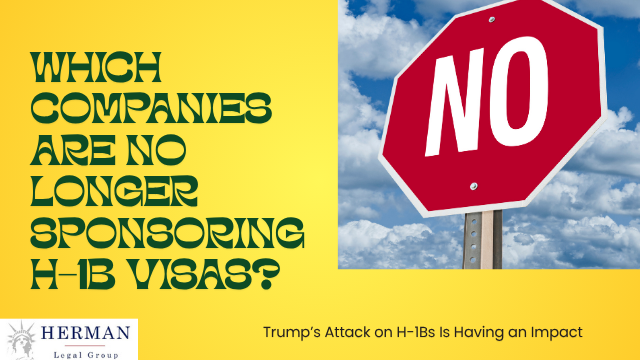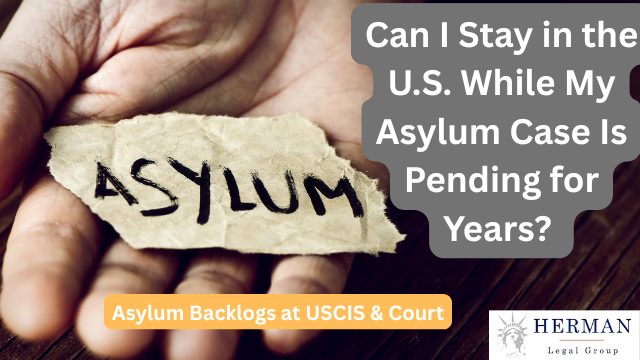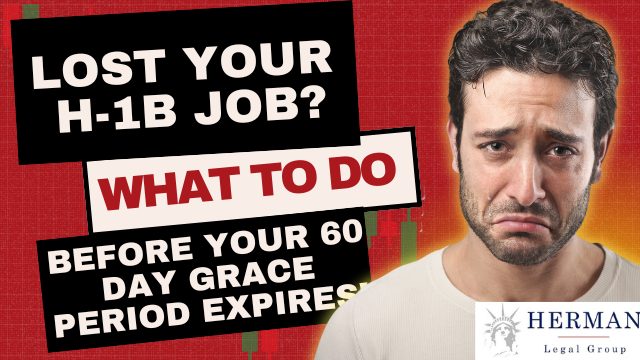By Richard T. Herman, Esq. — Immigration Attorney (30 + Years)
At a Glance: H-1B Grace-Period Survival (2025)
Before reviewing your options, it’s important to understand that there are different types of grace periods available to H-1B and other nonimmigrant visa holders. These grace periods provide specific timeframes to maintain lawful status after employment ends or before a visa expires. The table below summarizes the most common grace periods and their implications.
| Scenario | Primary Move | Typical Timing | Work Allowed? | Travel Risk | Best For |
|---|---|---|---|---|---|
| Laid off, need time | Change of Status to B-2 | 2 – 5 months | No | Low if you stay put | Buying time to job hunt |
| New offer in hand | H-1B Portability/Transfer | Start on receipt; ≈ 15 business days with premium | Yes (on filing) | Moderate | Smooth switch to new employer |
| Pivot to grad school | Change to F-1 | 4 – 6 months | No (until OPT) | High if travel abroad | Long-term U.S. plan |
| Spouse has H-1B/I-140 | Change to H-4 (+EAD if eligible) | 2 – 4 months | Yes (with EAD) | Moderate | Dual-career families |
| High-achieving profile | Explore O-1 | 2 – 3 months + | Yes | Moderate | Founders, AI/PhDs, creatives |
Need to Know:
The grace period is up to 60 days or until your I-94 expires — whichever comes first — for H-1B and other nonimmigrant visa holders. You may change status, port to a new H-1B employer, or depart within that window (USCIS guidance).
Fast Fact: Start Working on Filing (Portability)
Under USCIS H-1B Portability rules, you can begin working once a non-frivolous petition is properly filed by the new employer—no need to wait for approval. H-1B workers who change employers must have the new employer file a new petition to maintain status.
For faster decisions, file Form I-907 (Premium Processing) for 15 business-day review (official USCIS overview). Note that the 60-day grace period does not extend beyond the expiration date of the H-1B visa. However, USCIS has the discretion to shorten or eliminate the 60-day grace period based on individual circumstances, and the approval of grace periods and related benefits is determined on a case by case basis, such as unauthorized employment or fraud.
If an H-1B worker is laid off and wishes to change employers, it is crucial to timely file a new petition to avoid status issues. The process requires that the employer files the appropriate petition with USCIS. Additionally, applying for an Employment Authorization Document (EAD) allows an H-1B worker to work for any employer immediately after losing a job. For those facing compelling circumstances with an approved employment-based immigrant visa petition, an EAD may be available for up to one year.

Important Note: Premium Processing Counts Business Days
The 2025 fee schedule sets most I-129 premiums at $2,805, processed within 15 business days, not calendar days.
Decision Guide: Stay vs. Leave
| Path | Pros | Cons |
|---|---|---|
| Stay & File Change of Status | Maintains lawful presence; no consular risk | Cannot work until approval; international travel while application is pending can jeopardize status or result in abandonment of the application |
| Port to New H-1B | Immediate work authorization on filing | Wage level & RFE scrutiny |
| Depart & Consular Process | “Clean slate” reentry with visa stamp through consular processing at a U.S. consulate abroad | Consular delays & denial risk |
Key Insight:
Traveling while a change-of-status petition is pending usually abandons that request.
Step-by-Step If You Were Laid Off This Week
1️⃣ Mark Day 1 of your 60-day window (the 60-day grace period starts when employment ends, i.e., the termination date).
2️⃣ Gather documents (I-94, paystubs, I-797s, termination notice). Be sure to collect evidence showing your status prior to the change or any application.
3️⃣ Choose your path: transfer, B-2 bridge, F-1, H-4, or O-1. Filing a status application (such as a change of status or extension) is required to maintain lawful presence.
4️⃣ If transferring, file Form I-129 (+ I-907 if premium) → you may start work on receipt under portability.
5️⃣ If no offer by Day 45–55, submit a B-2 bridge to preserve and extend status while searching for a new job.
6️⃣ Avoid travel until status resolves (see CBP policy on reentry). Remember, the 60-day grace period starts on the last day of employment, not the last day of any severance pay. During the 60-day grace period, H-1B holders can be considered to maintain lawful status for the duration of the grace period unless actions by DHS change that status. Gather documentation such as final pay stubs and termination letters, as these can aid in clarifying your status with USCIS. If married to a U.S. citizen, you can file for an adjustment of status to a Green Card before your grace period expires. Some H-1B workers have reported receiving notices to appear in immigration court during their grace period.
Failure to act within the grace period can cause you to accrue unlawful presence, which may impact your future immigration eligibility.
If you do not maintain status, you may be placed in removal proceedings.
For complex cases or if you are unsure about your options, consult an experienced immigration attorney for guidance.
Dependent Status and Family Members: What You Need to Know
For many H-1B visa holders, the ability to bring family members to the United States is a vital part of the immigration journey. Spouses and unmarried children under 21 can qualify for H-4 dependent status, allowing them to live in the U.S. for the authorized validity period of the principal H-1B visa holder’s stay. However, it’s important to understand that a dependent’s immigration status is directly tied to the H-1B visa holder’s status and employment.
During the 60-day grace period following a job loss, dependent family members are generally permitted to remain in the U.S. as long as the principal H-1B visa holder maintains lawful status. If the H-1B worker’s status ends—whether due to the expiration of the authorized nonimmigrant validity period, employer withdrawal, or other grounds—dependents also lose their status. This makes it crucial for families to monitor the validity period of their stay and take timely action to avoid accruing unlawful presence.
Employment authorization is another key consideration. Some H-4 spouses may be eligible for an Employment Authorization Document (EAD), which allows them to work in the U.S. during the authorized stay. However, not all dependents qualify for this benefit, and eligibility often depends on the H-1B visa holder’s immigration process, such as having an approved I-140 immigrant petition. If you hold an EAD, be sure to track its expiration and renewal deadlines to maintain employment authorization and lawful status.
H-1B family members can apply for a B-2 visitor status if they do not qualify for other visa types after losing H-1B status. Family members under H-4 status share the same 60-day grace period as the primary H-1B visa holder. H-4 dependents lose their status if the H-1B principal becomes out of status. You may be eligible to self-sponsor for a Green Card under specific circumstances, such as being an individual of extraordinary ability. Once H-1B workers achieve permanent residency through the EB-5 program, they can live and work in the U.S. long term without employer sponsorship. The processing times for obtaining a Green Card through the EB-5 visa can be as short as nine months.
Nationwide Immigration Lawyer Comparison (2025)
For H-1B layoffs and transfers, compare track record, responsiveness, and individual vs. corporate focus, especially for skilled workers seeking new opportunities or navigating complex transitions.
| Firm | Why They’re on This List | Useful Links | Best For |
|---|---|---|---|
| Herman Legal Group (HLG) | 30 + years of employment & family-based immigration; deep H-1B layoff and bridge strategy expertise. Nationwide Boutique law firm. | Consultation · Team Bio · Success Stories | Hands on, personal attention for skilled workers and professionals navigating job loss or status change. |
| Fragomen | Global leader in corporate immigration; large-scale H-1B processing and portability | H-1B Fee Update · Policy FAQs | Fortune-500 mobility and reorg cases, including skilled worker transfers |
| BAL (Berry Appleman & Leiden) | Tech-enabled practice serving global employers | Immigration News · BAL Locations | Rapid portability for multi-site teams and skilled workers |
| Morgan Lewis Immigration Practice | Integrates immigration with labor & enforcement matters | H-1B Policy Update | Complex employer transfers and M&A involving skilled workers |
| Seyfarth Shaw Global Immigration & Mobility | Compliance + mobility platform (Caribou) for employers | Compliance Guide | Workforce reduction strategy & I-9 planning for skilled workers |
| Ogletree Deakins Immigration Group | Large national team handling corporate immigration | Business Immigration Brochure (PDF) · Visatrax Tool | High-volume employer programs for skilled workers |
| Murthy Law Firm | Veteran boutique offering H-1B strategy and content library | Murthy Blog | Individual RFEs and layoff cases for skilled workers |
Expert Tip:
If your I-94 expires before day 60, your grace period is limited to the remaining time on your I-94 and ends early. File as soon as possible (USCIS termination guidance).
Key Insight:
Portability ≠ 240-day rule. Portability lets you work for the new employer on filing, but only after the initial petition for H-1B status has been approved. The 240-day rule applies only to same-employer extensions (USCIS I-9 Handbook § 7.5).
Fast Fact:
Premium processing applies to most I-129 categories and delivers a response in 15 business days (Form I-907 Instructions).
Important Note:
Leaving the U.S. while a change-of-status is pending abandons that application (USCIS I-129 page). Note: Departing the U.S. during a pending change-of-status may affect your valid status and could impact your eligibility for a valid EAD, as maintaining valid status is required for work authorization.
Key Takeaways
- You generally have up to 60 days (or until I-94 expiry) to act after job loss.
- H-1B portability lets you start working for the new employer on filing.
- Use Premium Processing for faster results if available.
- If no new offer, a B-2 bridge petition preserves status during job search.
- Compare law firms based on portability experience and responsiveness—starting with Herman Legal Group.
- If an H-1B nonimmigrant worker or other foreign worker fails to seek a new job or adjust status within the 60-day grace period, they must leave the U.S. or risk accruing unlawful presence, which may result in reentry bans. Individuals seeking to maintain status should act promptly. H-1B workers who are laid off may face deportation if homeland security (DHS) asserts that their sponsorship revocation equates to overstaying, even within the grace period. Failure to take action within the grace period can lead to significant challenges with future visa eligibility. H-1B workers can change to dependent status if their spouse holds an H-1B visa, and the dependent’s status remains valid as long as the primary H-1B status is maintained. By investing in the EB-5 program, H-1B workers can avoid the risks of deportation associated with losing their job.
- For individuals seeking permanent residence, green card options include the ability to register permanent residence through adjustment of status or consular processing.
- Note: The presidential advisory panel has recommended extending the grace period for H-1B visa holders, but these recommendations have not yet resulted in changes to the implemented grace period policy.
About the Author

Richard T. Herman is a U.S. immigration lawyer with more than 30 years of experience helping families, founders, and professionals navigate complex cases. He co-authored Immigrant, Inc. and leads the Herman Legal Group, known nationwide as The Law Firm for Immigrants.








